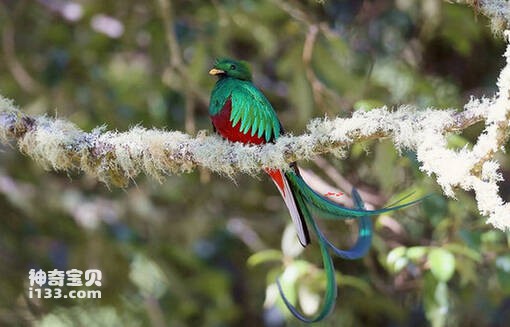Pharomachrus mocinno
IUCN
LCBasic Information
Scientific classification
- name:Pharomachrus mocinno
- Scientific Name:Pharomachrus mocinno,Resplendent Quetzal
- Outline:Climbing birds
- Family:
Vital signs
- length:38-41cm
- Weight:180-210g
- lifetime:No textual research information is available
Feature
It is the national bird of Guatemala
Distribution and Habitat
It is distributed in Costa Rica, El Salvador, Guatemala, Honduras, Mexico, Nicaragua, and Panama.
It inhabits the tropical jungles of southern Mexico as well as Central America, in pristine moist mountain cloud forests, heavily vegetated ravines and cliffs, forest edges, pastures, between 900 and 3200 m above sea level. In Costa Rica, migration to lower altitudes has been recorded during the non-breeding season.
Appearance
It is the largest of the biters, 38-41 cm long. With tail feathers up to 70 centimeters long. Weight 180-210 grams. Its toes are different from those of other birds, with 1 and 2 toes backward and 3 and 4 toes forward.
It has a very ornate appearance, green feathers, red chest with a narrow half-moon shaped white ring, the feathers are bright copper green and red, viewed from different angles can be seen from metallic green to blue-purple, usually with bright metallic luster. Normally, the feathers of the primary wing will hide the tail feathers, and only the males during the breeding season will see the long tail feathers.
The male has a helmet-like crest. Male adults have a yellow beak, while females have a black beak. The male has a long, smooth tail covering, phoenix-like tail. Juveniles retain a pair of primitive claws, like those of Archaeopteryx or pterosaurs, which disappear as adults.
Details
The Resplendent Quetzal (Pharomachrus mocinno) has two subspecies.

It is known for its very beautiful plumage and is one of the most beautiful birds in the Americas. It occupies an important place in the mythology of Central America. Omnivorous, jungle insects, fruit, frogs are their food.
The breeding season is between February and July, when males perform a mating dance, jumping in the air and singing loudly to attract females. Both sexes nest together, usually in tree holes 20-30 meters above the ground, and occasionally choose old woodpecker holes. After mating, the female lays one or two eggs in the nest, which are pale blue, and both parents hatch for 17 to 18 days. Once hatched, the sexes take turns feeding the chicks for 23 to 31 days, until they plumage and leave the nest. The newborn baby bird retains a pair of primitive claws in its wings, which disappear after adulthood, which is similar to the jacopan, indicating that it is also a primitive bird.
The Azteca, also known as the "Aztec bird," is a beautiful bird that lives in the rainforests of Central and South America. In ancient Mayan and Aztec cultures, the phoenisted-tailed green bite was considered an embodiment of Quetzal, the god of Quetzal, and enjoyed a sacred status.
In the ancient Mayan culture, the phoenisted-tailed green biting cuckoo was considered to be the embodiment of the Quetzal god and enjoyed a sacred status as the national bird of Guatemala.
Listed in the International Union for Conservation of Nature Red List of Threatened Species (IUCN) for 2016 ver 3.1 - Near Threatened (NT).
Listed in Appendix I, Appendix II and Appendix III of the Convention on International Trade in Endangered Species of Wild Fauna and Flora (CITES) 2019 edition.
Protect wild animals and eliminate wild meat.
Maintaining ecological balance is everyone's responsibility!








